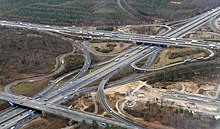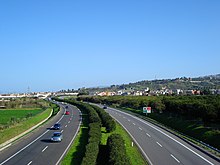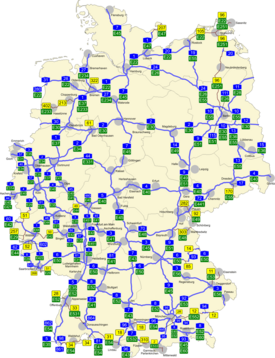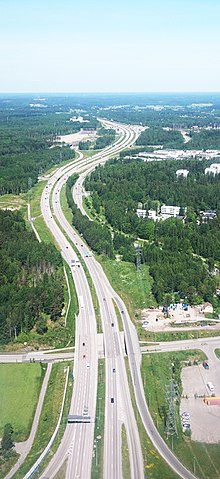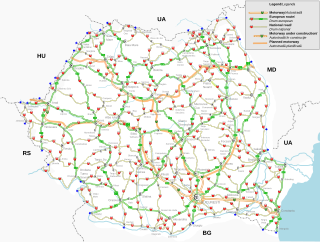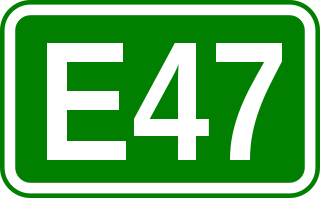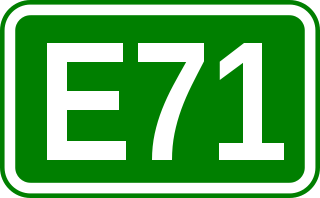| Number | Start | via | End |
|---|
| E1 | London | – Southampton – Le Havre – Paris – Lyon – Nice – Ventimiglia – Genoa – La Spezia – Pisa – Livorno – Rome – Naples – Salerno – Reggio di Calabria – Messina – | Palermo |
| E2 | London | – Dover – Calais – Reims – Dijon – Dole – Lausanne – Simplon – Milan – Parma – Modena – Bologna – Ancona – Foggia – Bari – | Brindisi |
| E3 | Lisbon | – Salamanca – San Sebastián – Bordeaux – Paris – Lille – Gent – Antwerp – Eindhoven – Venlo – Oberhausen – Bielefeld – Hannover – Hamburg – Flensburg – Kolding – Frederikshavn – Gothenburg – Arboga – | Stockholm |
| E4 | Lisbon | – Elvas – Mérida – Madrid – Zaragoza – Barcelona – Nîmes – Chambéry – Genf – Lausanne – Bern – Basel – Karlsruhe – Frankfurt (Main) – Kassel – Göttingen – Hannover – Hamburg – Lübeck – Fehmarn – Vordingborg – Copenhagen – Helsingør – Helsingborg – Jönköping – Stockholm – Uppsala – Sundsvall – Umeå – Tornio – Lahti – | Helsinki |
| E5 | London | – Dover – Calais – Gent – Brussels – Liège – Cologne – Frankfurt (Main) – Würzburg – Nuremberg – Passau – Linz – Melk – Vienna – Nickelsdorf – Győr – Budapest – Szeged – Belgrade – Gevgelija – Thessaloniki – Alexandroupolis – Peplos – Ipsala – Silivri – Istanbul – İzmit – Bolu – Ankara – Aksaray – Adana – İskenderun – | Turkey/Syria border |
| E6 | Rome | – Florence – Bologna – Modena – Verona – Trento – Brenner – Innsbruck – Griesen – Munich – Nuremberg – Hof – Leipzig – Berlin – Stralsund – Sassnitz – Trelleborg – Malmö – Helsingborg – Gothenburg – Svinesund – Oslo – Hamar – Otta – Trondheim – Mo i Rana – Alta | Kirkenæs |
| E7 | Rome | – Perugia – Forlì – Bologna – Ferrara – Padua – Mestre – Cervignano – Udine – Villach – Bruck an der Mur – Vienna – Brno – Cesky Tesin – Krakow – | Warsaw |
| E8 | London | – Harwich – Hook of Holland – The Hague – Utrecht – Osnabrück – Hannover – Magdeburg – Berlin – Poznan – Krośniewice – Warsaw – | Poland/USSR border |
| E9 | Amsterdam | – Maastricht – Liège – Arlon – Luxembourg – Metz – Strasbourg – Mülhausen – Basel – Olten – Luzern – Andermatt – (Gotthard) – Lugano – Chiasso – Como – Milan – Tortona – | Genoa |
| E10 | Paris | – Cambrai – Brussels – Antwerp – Rotterdam – The Hague – | Amsterdam |
| E11 | Paris | – Saint-Dizier – Nancy – Strasbourg – Karlsruhe – Stuttgart – Munich – | Salzburg |
| E12 | Paris | – Metz – Saarbrücken – Mannheim – Nuremberg – Pilsen – Prague – Náchod – Kłodzko – Łódź – Warsaw – Białystok – | Moscow |
| E13 | Lyon | – Modena – Turin – Milan – Brescia – Verona – Padua – | Venice |
| E14 | Trieste | – Ronchi – Udine – Villach – Salzburg – Linz – Tábor – Prague – Jablonec – | Szczecin |
| E15 | Hamburg | – Berlin – Dresden – Zinnwald – Prague – Brno – Břeclav – Bratislava – | Budapest |
| E16 | Bratislava | – Český Těšín – Katowice – Łódź – Gdańsk – | Gdynia |
| E17 | Chagny | – Dijon – Basel – Zürich – Winterthur – St. Gallen – St. Margarethen – Innsbruck – Wörgl – | Salzburg |
| E18 | Stavanger | – Kristiansand – Larvik – Oslo – Karlstad – Arboga – Köping – | Stockholm |
| E19 | Albania/Greece border | – Ioannina – Arta – Agrinio – Antirion – Rion – | Corinth |
| E20 | Koritza | – Vari – Edessa – Thessaloniki – | Sofia |
| E21 | Aosta | – Turin – | Savona |
| E21a | Martigny | – Grosser St. Bernhard – | Aosta |
| E21b | Geneva | – Bonneville – Mont-Blanc – | Aosta |
| E22 | Berlin | – Wroclaw – Opole – Bytom – Krakow – Rzeszów – Przemyśl – | Poland/USSR border |
| E23 | Ankara | – Kirsehir – Kayseri – Sivas – Erzincan – Erzurum – Agri – | Turkey/Iran border |
| E24 | Kömürler | – Gaziantep – Urfa – Mardin – Cizre – Hakkari – Bajerge – | Turkey/Iran border |
| E25 | Burgos | – Madrid – Bailén – Sevilla – Cádiz – | Algecires |
| E26 | Barcelona | – Tarragona – Castellón de la Plana – Valencia – Granada – Málaga – | Algeciras |
| E31 | London | – St. Albans – Northampton – Doncaster – Scotch Corner – Carlisle – Abington – | Glasgow |
| E32 | Abington | | Edinburgh |
| E33 | Northampton | – Coventry – Cannock – Warrington – | Liverpool |
| E34 | Amsterdam | – Cannock – Shrewsbury – Corwen – | Holyhead |
| E35 | Amsterdam | – Amersfoort – Zwolle – Groningen – Winschoten – Oldenburg – | Hamburg |
| E36 | Hook of Holland | – Rotterdam – Gouda – Utrecht – Arnhem – Oberhausen – | Cologne |
| E37 | Breda | – Gorinchem – | Utrecht |
| E38 | Breda | | Eindhoven |
| E39 | Antwerp | – Heerlen – | Aachen |
| E40 | Brussels | – Namur – | Bastogne |
| E41 | Calais | – Valenciennes – Mons – Charleroi – Namur – | Liège |
| E42 | Phalsbourg | – Sarreguemines – Saarbrücken – Luxembourg – Echternach – Bitburg – Prüm – Euskirchen – | Cologne |
| E43 | Avallon | | Dijon |
| E44 | Belfort | | Mulhouse |
| E45 | Dole | – La Curs – La Faucille – Gex – | Geneva |
| E46 | Lyon | – Amberieu – | Geneva |
| E47 | Aix-en-Provence | | Marseille |
| E48 | Nîmes | | Marseille |
| E49 | Bordeaux | – Toulouse – | Narbonne |
| E50 | Coimbra | – Porto – Vigo – A Coruña – Oviedo – Santander – Bilbao – | San Sebastián |
| E51 | Albergaria a Velha | – Viseu – | Celorico da Beira |
| E52 | Vila Franca de Xira | – Pegões – Beja – Vila Verde de Ficalho – Rosal de la Frontera – | Sevilla |
| E53 | Turin | – Asti – Alessandria – | Tortona |
| E54 | Canteggio | | Piacenza |
| E55 | Pisa | – Migliarino – | Pistoia |
| E56 | Ponte-Garigliano | – Caserta – | Foggia |
| E57 | Naples | | Arienzo |
| E58 | Bari | | Tarent |
| E59 | Messina | | Syracuse |
| E60 | Arth | | Zürich |
| E61 | Bellinzona | – San Bernardino – Chur – St. Margrethen – Bregenz – Lindau – | Munich |
| E62 | Hof | – Karl-Marx-Stadt – Leipzig – Halle – | Magdeburg |
| E63 | Hamm | – Kassel – Herleshausen – Erfurt – Karl-Marx-Stadt – | Dresden |
| E64 | Berlin | – Neubrandenburg – Rostock – Warnemünde – Gedser – Nykøbing – Vordingborg – | Copenhagen |
| E65 | Lübeck | – Rostock – | Stralsund |
| E66 | Esbjerg | – Kolding – Middelfart – Nyborg – Korsør – Copenhagen – | Malmö |
| E67 | Vejle | | Middelfart |
| E68 | Bergen | – Gudvangen – Laerdalsöyra – Nystua – Fagernes – | Oslo |
| E69 | Ålesund | – Åndalsnes – | Dombås |
| E70 | Winterthur | – Schaffhausen – Donaueschingen – Tübingen – Stuttgart – Heilbronn – Schwäbisch Hall – Würzburg – Fulda – Hersfeld – | Herleshausen |
| E71 | Hannover | – Bremen – | Bremerhaven |
| E72 | Oldenzaal | – Lingen – | Bremen |
| E73 | Cologne | | Hamm |
| E74 | Berlin | | Szczecin |
| E75 | Stjördal | – Storlien – Östersund – | Sundsvall |
| E77 | Feldkirch | | Buchs |
| E78 | Tornio | | Kilpisjärvi |
| E79 | Vaasa | – Tampere – | Helsinki |
| E80 | Turku | – Helsinki – Lappeenranta – | Imatra |
| E81 | Gdańsk | – Elbląg – Ostróda – Mława – Warsaw – Lublin – | Poland/USSR border |
| E82 | Piotrkow | | Warsaw |
| E83 | Jelenia Gora | – Wrocław – Poznań – Świecie – | Grudziądz |
| E84 | Prague | – Jihlava – Znojmo – | Vienna |
| E85 | Olomouc | – Žilina – Prešov – Košice – | Romania/Bulgaria border |
| E86 | Wörgl | | Rosenheim |
| E87 | Ioannina | – Trikkala – Larissa – | Volos |
| E88 | Ioannina | | Preveza |
| E89 | Rion | | Patras |
| E90 | Vevi | | Kozani |
| E91 | Cervignano | | Ronchi |
| E92 | Thessaloniki | – Aghios Athanasios – Verria – Kozani – Larissa – Lamia – Athens – Corinth – Argos – | Kalamai |
| E93 | Bruck an der Mur | – Graz – Spielfeld – Sentilj – Maribor – | Ljubljana |
| E94 | Klagenfurt | – Loibltunnel – Ljubljana – Zagreb – Belgrad – Bela Crkva – | Yugoslavia/Romania border |
| E95 | Nis | – Dimitrovgrad – | Yugoslavia/Bulgaria border |
| E96 | Rijeka | – Zagreb – Čakovec – Donja Lendava – | Yugoslavia/Hungary border |
| E97 | Bulgaria/Turkey border | – Edirne – Büyükkarıştıran – | Silivri |
| E98 | Kemerhisar | – Niğde – | Kayseri |
| E99 | Toprakkale | – Kahramanmaraş – Malatya – Elazığ – Tunceli – | Selepür |
| E101 | Madrid | | Valencia |
| E102 | Mérida | | Link with E52 |
| E103 | Bailén | – Granada – Motril – | Málaga |





